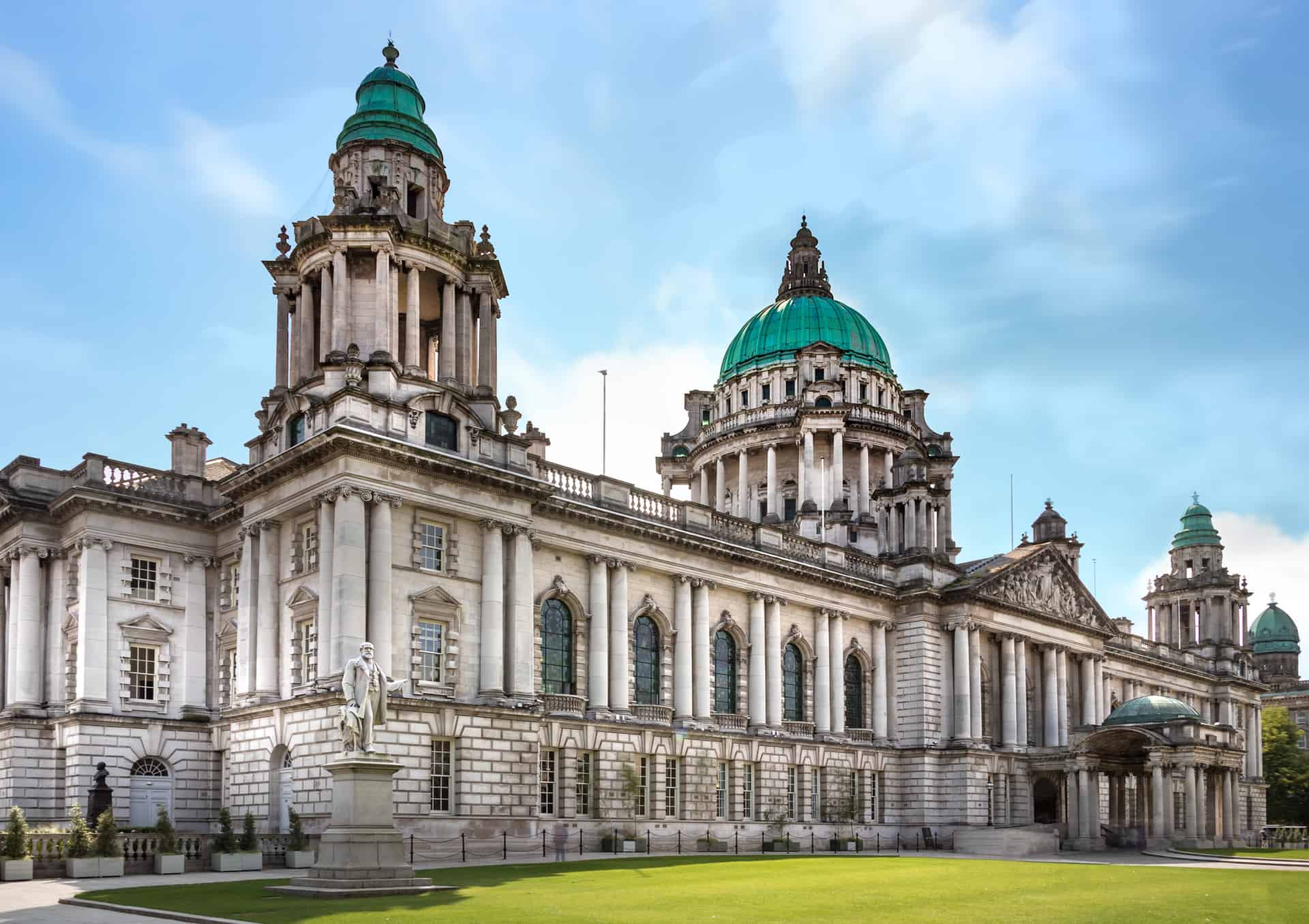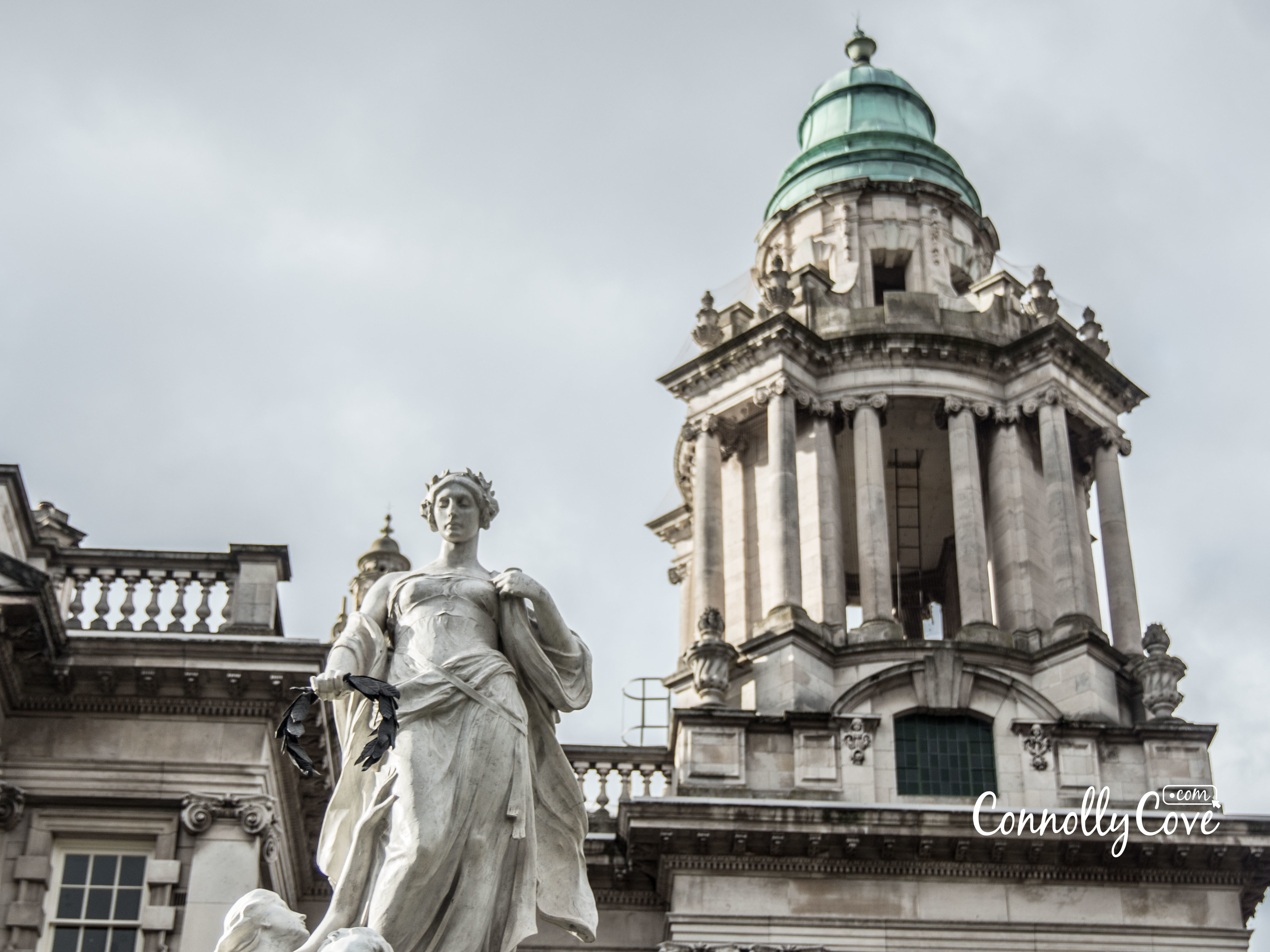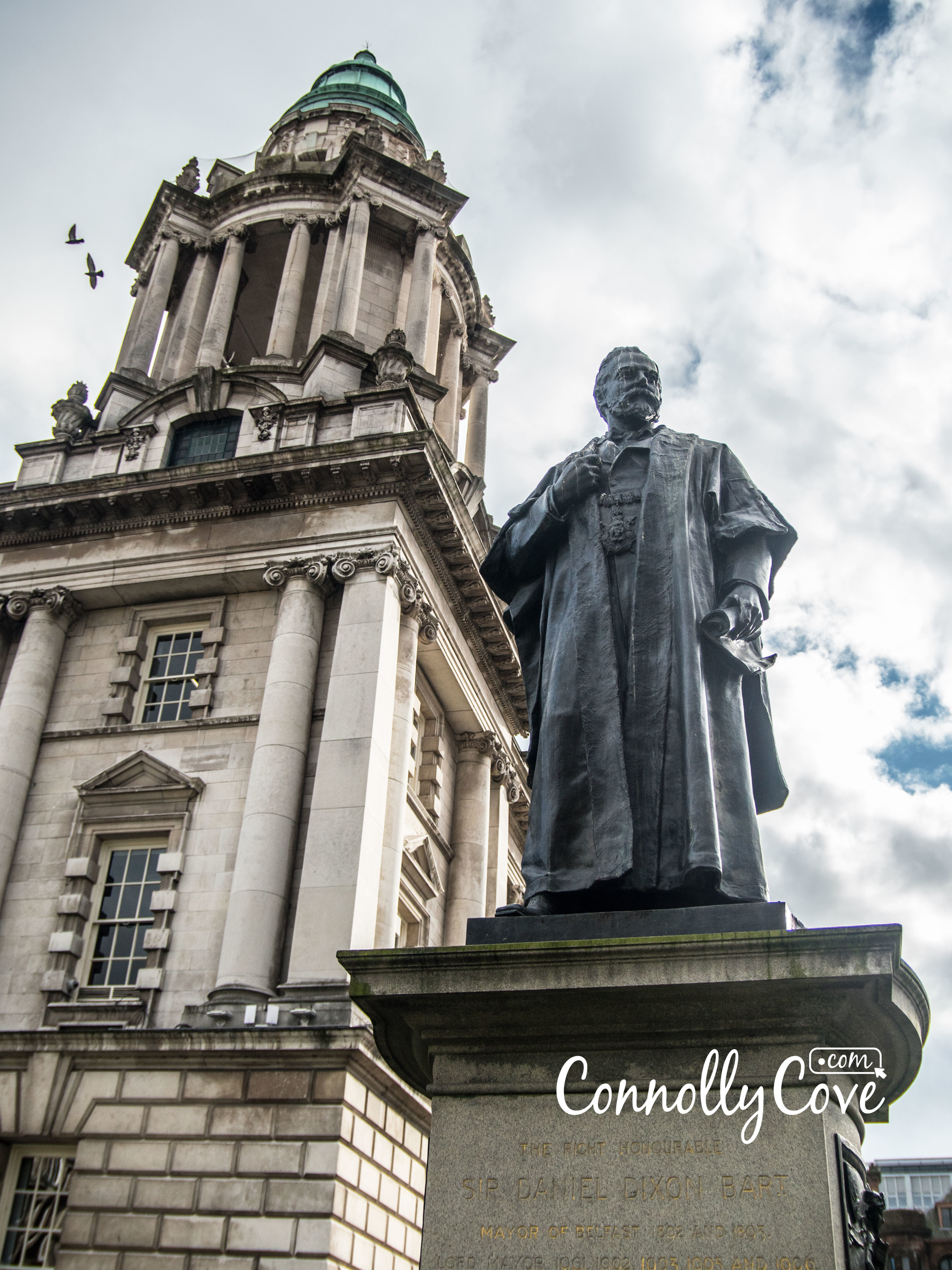Exploring Belfast City Hall

Updated On: April 07, 2024 by Shaimaa Olwan
In the bustling heart of Belfast, amid the rhythm of urban life, stands a towering monument to the city’s storied past and enduring spirit: Belfast City Hall. With its striking Edwardian Baroque architecture and rich historical significance, this majestic civic building serves as a beacon of civic pride and a symbol of Belfast’s journey through time.
From its inception in the late 19th century to its present-day role as a focal point for community gatherings and cultural celebrations, Belfast City Hall stands as a testament to Northern Ireland’s capital city’s resilience, creativity, and heritage. In this article, we delve into the history, architecture, and significance of Belfast City Hall, exploring its role in shaping the identity and landscape of Belfast for over a century.
Come along with us as we take a day trip into Belfast City Centre to explore the interior of the History Belfast City Hall. The City Hall in Belfast has a long and exciting history worth exploring.
City Hall Tour
Belfast is known to be one of the most prominent counties in Northern Ireland. If you only have to visit one county, then Belfast should be. You can have a lot of tours there. One tour that you should go on is around Belfast City Hall.
There are a lot of statuses with stories to unfold and a lot of exciting stuff to learn about. As this video shows, the tour is quite interesting and suitable for an entertaining family outing. Let’s learn about the history of the significant monuments in the above video.

What is Belfast City Hall?
It is hard not to hear about Belfast City Hall regarding the history of Ireland. It is a civic building that sits in Donegall Square in County Belfast. The building serves as Belfast City Council.
Moreover, the significance of this place lies in how it divides the business areas of the city centre. Such a division is made effectively and favours the city’s commercial status considerably.
The External Appearance of the Building
The building covers around one and a half acres and has a courtyard adjacent to it. However, the courtyard is enclosed. Regarding the external style of the building, it is made in the Baroque Revival Style. The latter is an architectural style that dates back to the late 19th century.
Above and beyond, the main element of the building’s structure is Portland Stone. Interestingly, the four corners of the building feature towers, one at each corner. The towers have domes coated with copper, and lanterns crown them on the top.
One of the prominent structures within is the Titanic Memorial, which sits on the grounds of Belfast City Hall. This memorial is a portrayal of a female who personifies death and unfortunate fate. Over the status’ head is a wreath of a sailor who drowned. The waves raise him above with the assistance of two mermaids.
The sculpture’s objective is to present the disaster of Titanic that took place in 1912. It commemorates the lives taken by the tragic sinking ship. Thanks to the victims’ families, the shipyard workers, and the public. They contributed significantly to erecting the memorial to keep the lost souls alive.

Interior Design of the Hall
As fancy as the exterior, the insides of the city hall are coated with fantastic marble and other high-quality materials. Besides, there are more than a few types of marble and not just a single one. The City Hall embraces several artworks, including stained glass windows, statues, paintings, and more. Those works of art memorialize many prominent figures who had a significant role in Irish history. This includes Mary-Anna McCracken, the humanitarian who fought slavery and set up schools.
The most noticeable commemoration of all is represented in the stained glass windows. The painting features Queen Alexandria and King Edward VII. They both sat on the throne when the City Hall started. The other painting features a marble sculpture of Fredrick Richard Chichester. He was the patron of the arts and the last Earl of Donegal. The Earl is portrayed lying on his deathbed with his caring mother.
History of Belfast City Hall
Here is a brief history of Belfast City Hall. Before the occupation of Belfast City Hall, the building served as the home of the White Linen Hall. The latter was an imperative international Linen Exchange. However, things changed in 1888, but the back street of the hall is called Linen Hall Street. The name is like a dedication to what the building once was.
In 1888, Queen Victoria awarded Belfast the status of a city. That was when plans for the City Hall all started. At that time, Belfast was highly recognised and even became more densely inhabited than Dublin. It goes back to the fact that the city’s expansion was rapid at that time. The town also became famous for housing many industries, including engineering, linen, shipbuilding, and rope making.
The Beginning of Construction
While the plans for the Belfast City Hall started in 1888, the construction took place 10 years later. Sir Alfred Brumwell Thomas was the architect responsible for supervising the process until it ended in 1906. Many significant firms contributed to the construction of the building, including WH Stephens, H&J Martin, and more.
Interestingly, in 1910, architect Stanley G. Hudson was inspired by the design of Belfast City Hall. Thus, he built an identical style in South Africa for the City hall in Durban. The same can be said about the Port of Liverpool Building. While it is not similar, it is still a lot closer to the design of the Irish Hall.
Belfast City Hall through the Wreckage
Belfast City Hall remained a sturdy structure for as many years. However, a noticeable destruction had taken its toll on it during World War II. The building endured a direct hit during the Belfast Blitz.
That wreckage could have been easily renovated. However, it was left as a decision taken by the city. Their objective was not to commemorate the unfortunate Blitz, but they wanted to memorialize the lives lost during the tragedy. There would never have been a better commemoration than keeping the bits of the actual event.
Major Developments of Belfast City Hall
Starting from 2011, the building began to witness significant renovations. Two developments remain the most prominent of them all. The first development was the Belfast Big Screen, found on the City Hall grounds. Its purpose is to allow people to experience both cultural and sporting events.
In actual fact, the erection of the big screen as part of the London Olympics Heritage. But, the good news is that is not the only thing the development serves. It also assists in emphasising the critical issues of the council all across the city. Over and beyond, it works wonderfully in advertising the latest events and news, especially for visitors.
The other development was the emergence of the Illuminate Project. It was a whole new introduction to the Irish culture. The Project lightens up the City Hall in a variety of colours as a means to display the culture of Belfast. The City Hall illuminates specific colours on special holidays to symbolise the day. For example, it illuminates yellow and blue during the celebration of World Down Syndrome Day.
Moreover, it was illuminated in yellow, black, and red as a support to the lives lost in the attacks of Brussels. Besides, it illuminates green during the celebration of Saint Patrick’s Day and red for May Day.
Memorials and Statuses to Enjoy in Belfast City Hall
Works of art are always fascinating. Belfast City Hall is a fantastic destination to enjoy unique statuses and memorials. Besides, the gardens surrounding the building are a great place to relax and enjoy the scenery of the green areas. It is a popular spot where tourists and young people gather to enjoy their time.

Queen Victoria Status
Within the grounds of Belfast City Hall lies a statue dedicated to Queen Victoria. Sir Thomas Brock was the one behind erecting the statue. You can quickly notice the statue standing tall, revealing the beauty and power that the Queen possessed.
The American Expeditionary Force
The American Expeditionary Force played a role in the history of Ireland. For that, you can find a granite column dedicated to it. The column is dedicated to the American Force that was based in Belfast.
The Figure of Thane (The Titanic Memorial)
We have already mentioned the marble figure that commemorates the tragedy of Titanic and the lives lost in the accident. Sir Thomas Brock also designed the figure; he was one of the leading architects in Ireland. Before being moved to the grounds, the monument used to sit at the front gate of the City Hall.
The Titanic ship was built in Harland and Wolff’s shipyard. The former head of the firm also has a memorial within the hall’s grounds. It is a sculpture dedicated to Sir Edward Harland, designed by Thomas Brock, like most other monuments. Harland also used to be the Mayor of Belfast beside the owner of the famous firm.
The Memorial of the Main War
This significant memorial of Northern Ireland sits within the walls of the Belfast City Hall. Two gardens are also crucial to the event: the Cenotaph and the Garden of Remembrance. On Remembrance Day, people visit the place and place wreaths at the gardens.
Belfast City Hall is steeped in decades of fascinating history, including the building itself, what happens inside, and the many amazing features that make it unique. People can also get married here and attend various events and award ceremonies yearly. Highly recommend the tour of the city hall if you would like to know more about its past and present.
Have you visited Belfast City Hall? Or is it somewhere you would like to visit while in Belfast? Let us know!
Also, don’t forget to check out our other blogs that might interest you: Tour of Belfast City| Belfast Peace Walls|Dead Centre Tours and History of Troubles| Bus Tour Belfast| St. Annes Cathedral Belfast|Peace Bridge Derry| Bogside Murals|






